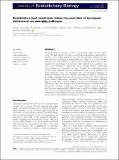Files in this item
Quantitative host resistance drives the evolution of increased virulence in an emerging pathogen
Item metadata
| dc.contributor.author | Gates, Daisy Elizabeth | |
| dc.contributor.author | Valletta, John Joseph | |
| dc.contributor.author | Bonneaud, Camille | |
| dc.contributor.author | Recker, Mario | |
| dc.date.accessioned | 2020-06-25T16:30:06Z | |
| dc.date.available | 2020-06-25T16:30:06Z | |
| dc.date.issued | 2018-11-02 | |
| dc.identifier | 268155661 | |
| dc.identifier | ea45c9e5-adfe-45c6-a7f5-5fdc3b1a6da9 | |
| dc.identifier | 85052976127 | |
| dc.identifier | 30107064 | |
| dc.identifier.citation | Gates , D E , Valletta , J J , Bonneaud , C & Recker , M 2018 , ' Quantitative host resistance drives the evolution of increased virulence in an emerging pathogen ' , Journal of Evolutionary Biology , vol. 31 , no. 11 , pp. 1704-1714 . https://doi.org/10.1111/jeb.13366 | en |
| dc.identifier.issn | 1010-061X | |
| dc.identifier.uri | https://hdl.handle.net/10023/20154 | |
| dc.description.abstract | Emergent infectious diseases can have a devastating impact on host populations. The high selective pressures on both the hosts and the pathogens frequently lead to rapid adaptations not only in pathogen virulence but also host resistance following an initial outbreak. However, it is often unclear whether hosts will evolve to avoid infection‐associated fitness costs by preventing the establishment of infection (here referred to as qualitative resistance ) or by limiting its deleterious effects through immune functioning (here referred to as quantitative resistance ). Equally, the evolutionary repercussions these different resistance mechanisms have for the pathogen are often unknown. Here, we investigate the co‐evolutionary dynamics of pathogen virulence and host resistance following the epizootic outbreak of the highly pathogenic bacterium Mycoplasma gallisepticum in North American house finches (Haemorhous mexicanus ). Using an evolutionary modelling approach and with a specific emphasis on the evolved resistance trait, we demonstrate that the rapid increase in the frequency of resistant birds following the outbreak is indicative of strong selection pressure to reduce infection‐associated mortality. This, in turn, created the ecological conditions that selected for increased bacterial virulence. Our results thus suggest that quantitative host resistance was the key factor underlying the evolutionary interactions in this natural host–pathogen system. | |
| dc.format.extent | 11 | |
| dc.format.extent | 659515 | |
| dc.language.iso | eng | |
| dc.relation.ispartof | Journal of Evolutionary Biology | en |
| dc.subject | House finches | en |
| dc.subject | Mathematical model | en |
| dc.subject | Mycoplasma gallisepticum | en |
| dc.subject | Qualitative resistance | en |
| dc.subject | Quantitative resistance | en |
| dc.subject | Virulence evolution | en |
| dc.subject | QH301 Biology | en |
| dc.subject | Ecology, Evolution, Behavior and Systematics | en |
| dc.subject | T-NDAS | en |
| dc.subject | SDG 3 - Good Health and Well-being | en |
| dc.subject.lcc | QH301 | en |
| dc.title | Quantitative host resistance drives the evolution of increased virulence in an emerging pathogen | en |
| dc.type | Journal article | en |
| dc.contributor.institution | University of St Andrews. Statistics | en |
| dc.identifier.doi | https://doi.org/10.1111/jeb.13366 | |
| dc.description.status | Peer reviewed | en |
This item appears in the following Collection(s)
Items in the St Andrews Research Repository are protected by copyright, with all rights reserved, unless otherwise indicated.

